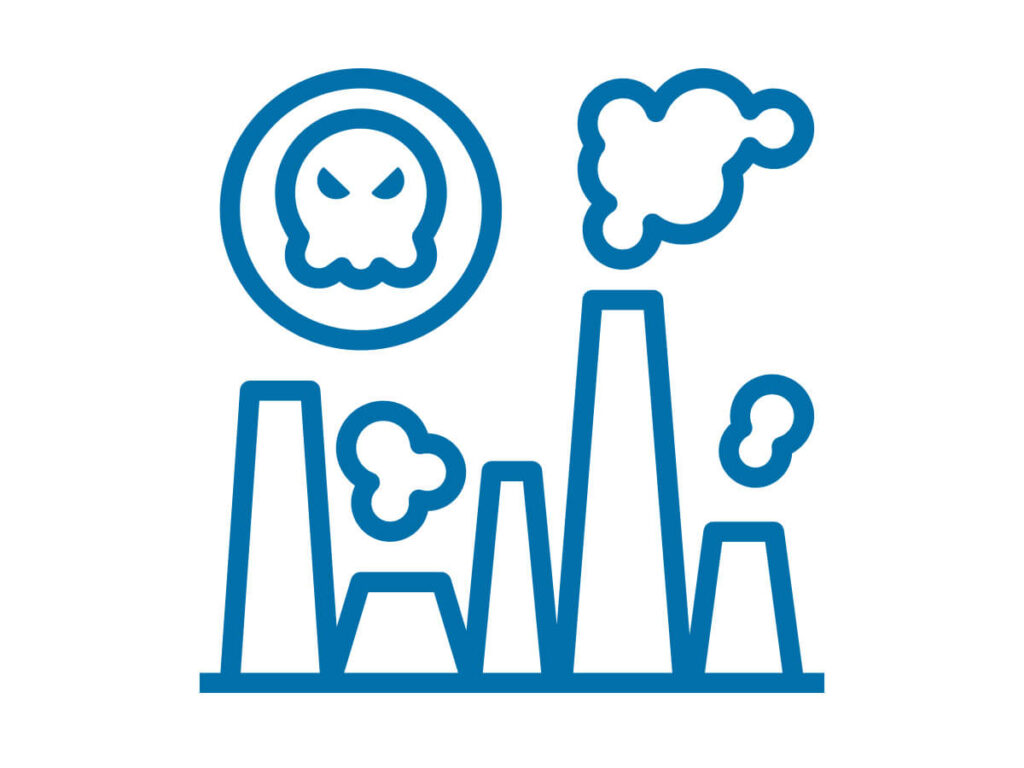Hazardous Air Pollutants (HAPs)
Through the Clean Air Act (CAA), federal, state, and local governments regulate the emissions of 188 toxic air pollutants. To safeguard your manufacturing operations, your facilities must meet the control standards for HAPs in your process.
Hazardous air pollutants (HAPs), also known as toxic air pollutants, are known or suspected to cause cancer and other serious health effects as well as adverse environmental effects. All levels of government regulate 188 toxic air pollutants to reduce their emissions into the environment.
Examples of toxic air pollutants include:
- benzene
- methylene chloride
- dioxin, asbestos, and toluene
- metals such as cadmium, mercury, chromium, and lead compounds
There are two (2) phases in controlling hazardous air pollutants from industrial facilities:
- Phase one (1) is technology-based and uses EPA-developed standards for controlling air pollution from industry-specific sources. These standards, called Maximum Achievable Control Technology (MACT), are based on already achieved emission levels by the best-controlled and lowest-emitting sources within an industry. The minimum standard that an industry must meet in order to comply with is called the “MACT floor”.
- Phase two (2) is a risk-based approach, where the EPA determines whether more health-protective control standards are necessary.
Note: After 8 years of setting the MACT standards, the Clean Air Act requires the EPA to review the health risks from each source category to determine whether the standards protect public health and protects against adverse environmental effects. It is important to keep up to date on any standard changes for your industry.
Common Industries with HAPs
All industries that Pollution Systems offers solutions for deal with some amount of hazardous air pollutants. Click each link to find specific information about your industry.
- Transportation Electrification
- Recovery & Recycling
- Ethylene Oxide Treatment
- Tank & Pipeline Degassing
- Microelectronics
- Building Materials
- Pharmaceuticals
- Metal Finishing
- Biofuels
- Mineral Processing
- Petrochemical Processing
- Midstream
Abatement Technology For HAPs
The properties of each HAP varies, so any one of the abatement systems we offer could be suitable to treat these air emissions.

Tailored Solutions for your HAPs Emissions
The proper solution for HAPs depends on the specific pollutant that needs treatment; therefore, it is difficult to say what system a facility needs without a detailed understanding of the application. Reach out to our technical sales group to understand the potential solutions based on your specific needs.

Glossary
The additional federal standards for emission units that are required to be followed at major sources, but can also be applied to area sources. These industry-specific standards are implemented beyond air permit requirements.
Technology-based standards that derive from the emission levels that are already being met by the best-controlled and lowest-emitting sources within an industry sector.
The maximum amount of pollutants a facility can emit in a year if under continuous operations. These calculations determine if an air permit is necessary for the facility, as well as what standards they are required to follow.
Sources that can potentially emit more than 10 tons per year of a single HAP or 25 tons per year of any combination of HAPs. Large industrial facilities are often major sources.
Sources that can potentially emit less than 10 tons per year of a single HAP or 25 tons per year of any combination of HAPs. Many small businesses are area sources.
Related Case Studies
Sterilization Facility Cuts Emissions With Catalytic Oxidizer System
A medical sterilization facility needed to cut ethylene oxide (EtO) emissions from their process stream. Our Catalytic Oxidizer was tailored to their application and was able to offer a >99% DRE.
- Pollutant: Hazardous Air Pollutants (HAPs)Volatile Organic Compounds (VOCs)
- Industry: Ethylene Oxide Treatment
- System: Catalytic Oxidizers
Enclosed Flare Abates Waste Acid Gas for Midstream Amine Facility
A midstream processor needed an air pollution control solution that could intermittently treat their waste acid gas exhaust during plant shutdowns. The amine facility used an Enclosed Flare to successfully abate these pollutants.
- Pollutant: Volatile Organic Compounds (VOCs)
- Industry: Midstream
- System: Enclosed Flares

